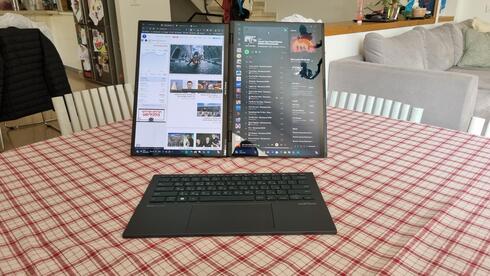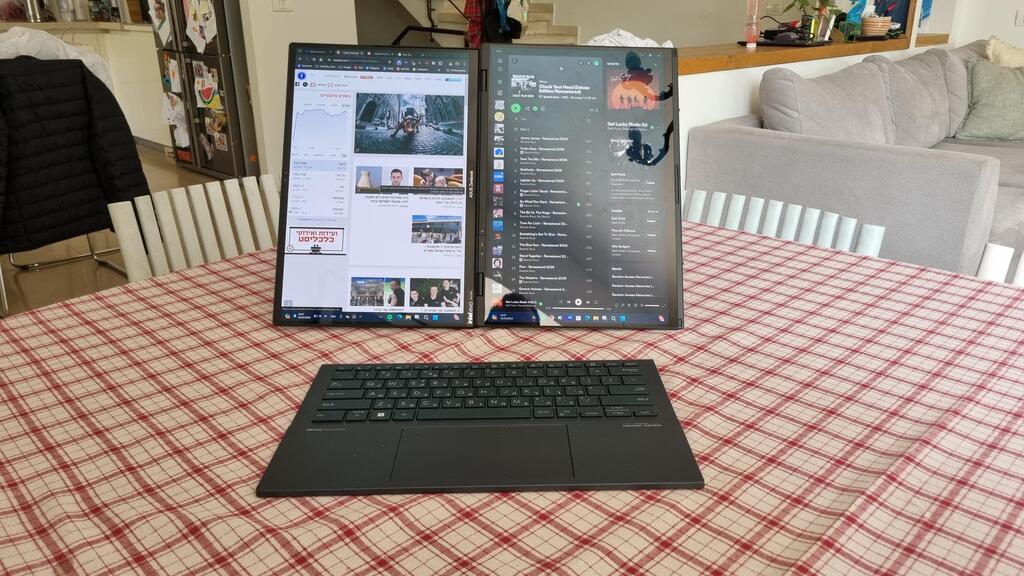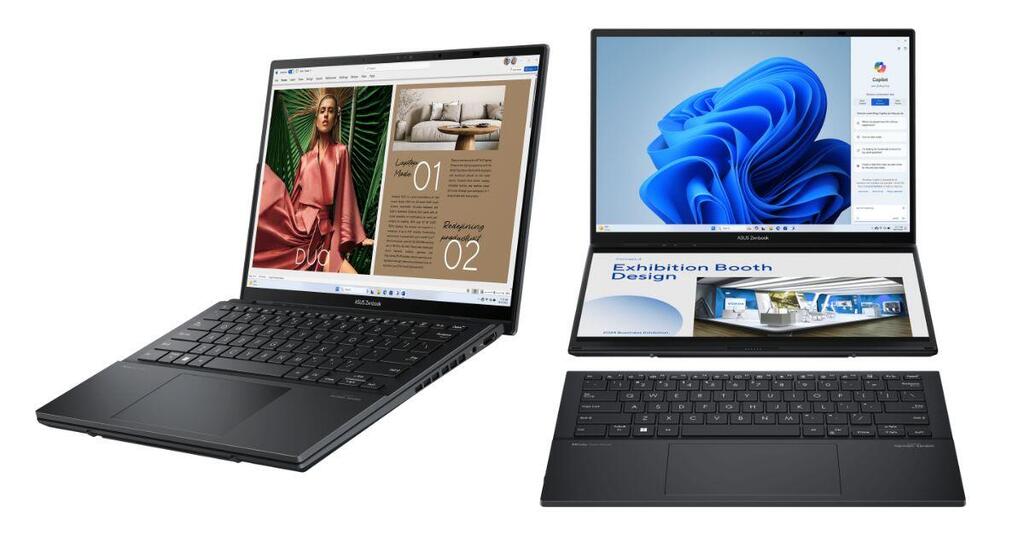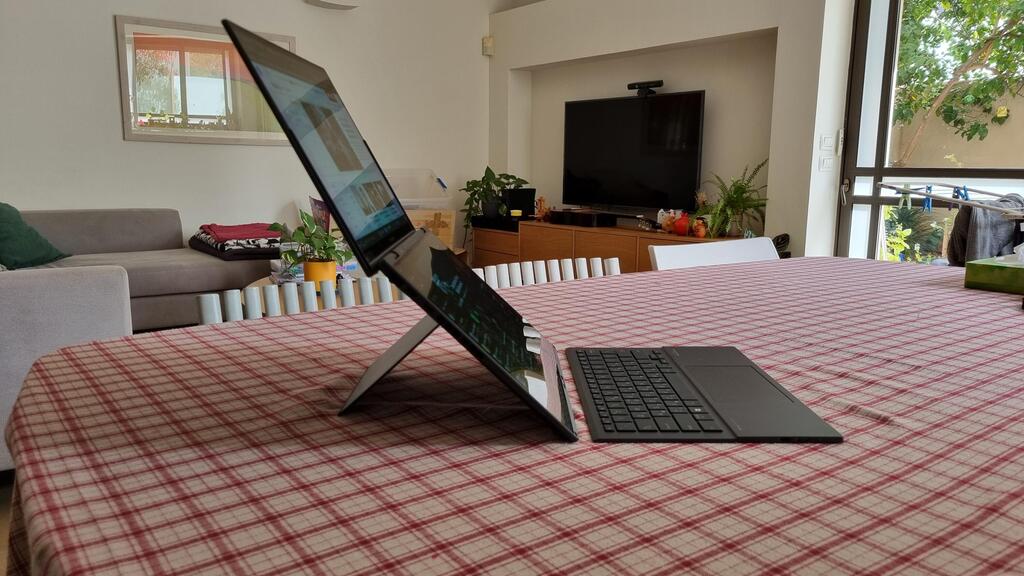
Laptop review
Asus ZenBook Duo: Is this mobile workstation worth its price?
The Asus laptop includes two touch screens, and can suit those who want another screen without being tied to a fixed workstation. It’s not very heavy, doesn’t excel in heavy graphic tasks and costs as much as 2-3 powerful computers
Top Line
For a moment you might think that this is a gimmick - you can get by with one screen, like any regular laptop, so why put together two touch screens? But there is something logical in the arrangement of the Asus Zenbook Duo: it can be used like a normal laptop, with a keyboard that is external but integrates without problems into the computer. And when you want to or need to, you can switch to the display of two screens, and this is also a useful and logical option, really not just a gimmick.
However, this option comes at a price, with the Duo often being sold for over $3,000. With this amount you can buy several computers or one powerful computer and an external screen.
The Duo is not perfect: the complete package, i.e. computer, keyboard and charger, weighs close to 2 kg, it does not excel in heavy graphic tasks, the sound from the speakers is not always good and the price is high, as mentioned.
And there is another slight problem: these are indeed two screens and they are not small for a laptop, but they are not the size that is usually found in a stand that includes two separate screens. When the screens are placed vertically, side by side, the common arrangement in many workstations, they are narrow due to the limitations of a laptop. That is, it is not a full replacement for two full screens, but a mobile solution, with its advantages and disadvantages.
Who will it suit? For those who are not deterred by the price (or it's simply not a consideration for them), those who need two screens anywhere and everywhere and also for those who want to make an impression.
Details
Working with two computer screens is no longer as rare as it used to be. True, not everyone needs it and you can still get by with one screen, but on the other hand the prices of the screens are no longer sky high and technically this is not a problem either.
There are also solutions for those who work with a laptop - to add an external screen or docking station. Asus offers another way: ZenBook Duo, a laptop with two 14-inch touch screens each, similar to Lenovo's Yoga Book 9i. Asus had previously launched a model with a similar name (the full name was Pro Duo), only there was an additional small screen at the bottom, above the keyboard. This time it is two large screens and an external keyboard that can be placed on the lower screen.
Now you can work from anywhere with two screens, and the new model offers several different options for using it. But is it practical?
Hardware: Strong on paper, but not for graphic tasks
The ZenBook Duo is powered by Intel's Core Ultra 9 processor and has 32 GB of memory and a 2 TB SSD drive. The graphics card is also from Intel, Arc, so it's not a computer for gamers, but it's also not a computer for office work only or "for students" - it's fast, powerful and handles a variety of tasks. When I loaded it with a relatively heavy graphic task, it delayed for a good few seconds. It isn't something that you can't live with, but it is also fair to expect a little more from a computer with such specifications (and price).
The Duo offers enough external connections: there are two USB-C / Thunderbolt sockets, one USB-A socket, an HDMI connection and a headphone socket - all located on the lower screen. The external keyboard has its own USB-C connection for charging.
The outstanding stars of the Duo are the two OLED screens, with an excellent color display and a high level of brightness, thanks to which you can work with the computer even in the sun.
The speakers are Harman Kardon, with support for Dolby Atmos, and while watching some video clips, you could hear a surround sound effect. On the other hand, when I started Spotify most of the songs didn't sound good, and changing the Dolby audio profile settings didn't help either.
The battery lasts for about 8 hours, depending of course on the nature and workload of the tasks. The charger provided by Asus is quite compact and connects to the USB-C socket, and adds a weight of about 180 grams. The battery charged from 10% to 50% in about 40 minutes and a full charge took about an hour and a half.
Interface and software: it's time to update Windows
The model that arrived for testing included Windows 11 in the Home version, which still requires improvement when it comes to touch screens. You can use a mouse and a keyboard, there is also an Asus pen, but on a computer that includes two touch screens, it only makes sense to touch the screen with your fingers. However, to close a folder window or a Chrome tab with a finger touch, I had to try two or three times to find the appropriate point.
Working with both screens open in a balanced mode makes it even more difficult to use a touch screen. In this mode, the upper screen is further away, but that's exactly why there are two screens, and it's better to focus on touch on the lower screen.
Asus has some of its own additions, for example a menu that helps divide the display between the screens: when you drag an open window or browser tab, you can choose in the Windows menu which part of the screen to pin it to, and there is also an Asus menu through which you can choose which screen to display it on.
There is even an option to unify the display so that one window is displayed on both screens. It's nice, but not always practical: if it's a Word document, for example, you'll get more space to display it. However, in Netflix, for example, the profile menus are displayed exactly at the connection between the screens and the movie or series is split and cut between the screens.
With a standard and separate display for two screens, you can easily find what to do with them - watch a lecture or participate in a Zoom call on one screen and write a summary on the other screen, draw with a pen on one screen and display a list of songs on the other screen, compare documents or photos and much more.

















